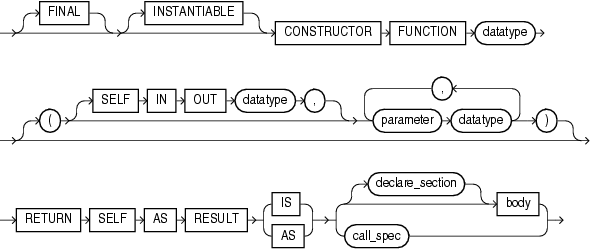| Oracle® Database PL/SQL Language Reference 11g Release 2 (11.2) Part Number E25519-05 |
|
|
PDF · Mobi · ePub |
| Oracle® Database PL/SQL Language Reference 11g Release 2 (11.2) Part Number E25519-05 |
|
|
PDF · Mobi · ePub |
The CREATE TYPE BODY defines or implements the member methods defined in the type specification that was created with the "CREATE TYPE Statement".
For each method specified in a type specification for which you did not specify the call_spec, you must specify a corresponding method body in the type body.
Note:
If you create a SQLJ object type, then specify it as a Java class.Every member declaration in the CREATE TYPE specification for an ADT must have a corresponding construct in the CREATE TYPE or CREATE TYPE BODY statement.
To create or replace a type body in your schema, you must have the CREATE TYPE or the CREATE ANY TYPE system privilege. To create a type in another user's schema, you must have the CREATE ANY TYPE system privilege. To replace a type in another user's schema, you must have the DROP ANY TYPE system privilege.

See:


See:

See:

See "call_spec ::=".
map_order_func_declaration ::=

Re-creates the type body if it exists, and recompiles it.
Users who were granted privileges on the type body before it was redefined can still access the type body without being regranted the privileges.
You can use this clause to add member subprogram definitions to specifications added with the ALTER TYPE ... REPLACE statement.
Name of the schema containing the type body. Default: your schema.
Name of an ADT.
The type of function or procedure subprogram associated with the type specification.
You must define a corresponding method name and optional parameter list in the type specification for each procedure or function declaration. For functions, you also must specify a return type.
proc_decl_in_type, func_decl_in_type
A procedure or function subprogram declaration.
A user-defined constructor subprogram declaration. The RETURN clause of a constructor function must be RETURN SELF AS RESULT. This setting indicates that the most specific type of the value returned by the constructor function is the most specific type of the SELF argument that was passed in to the constructor function.
See Also:
"CREATE TYPE Statement" for a list of restrictions on user-defined functions
"Overloaded Subprograms" for information about overloading subprogram names
Oracle Database Object-Relational Developer's Guide for information about and examples of user-defined constructors
Declares items that are local to the procedure or function.
Procedure or function statements.
See "call_spec" and "EXTERNAL".
You can declare either one MAP method or one ORDER method, regardless of how many MEMBER or STATIC methods you declare. If you declare either a MAP or ORDER method, then you can compare object instances in SQL.
If you do not declare either method, then you can compare object instances only for equality or inequality. Instances of the same type definition are equal only if each pair of their corresponding attributes is equal.
Declares or implements a MAP member function that returns the relative position of a given instance in the ordering of all instances of the object. A MAP method is called implicitly and specifies an ordering of object instances by mapping them to values of a predefined scalar type. PL/SQL uses the ordering to evaluate Boolean expressions and to perform comparisons.
If the argument to the MAP method is null, then the MAP method returns null and the method is not invoked.
An type body can contain only one MAP method, which must be a function. The MAP function can have no arguments other than the implicit SELF argument.
Specifies an ORDER member function that takes an instance of an object as an explicit argument and the implicit SELF argument and returns either a negative integer, zero, or a positive integer, indicating that the implicit SELF argument is less than, equal to, or greater than the explicit argument, respectively.
If either argument to the ORDER method is null, then the ORDER method returns null and the method is not invoked.
When instances of the same ADT definition are compared in an ORDER BY clause, the database invokes the ORDER MEMBER func_decl_in_type.
An object specification can contain only one ORDER method, which must be a function having the return type NUMBER.
A function subprogram declaration. See "CREATE PROCEDURE Statement" and "CREATE FUNCTION Statement" for the full syntax with all possible clauses.
Deprecated way of declaring a C method, supported only for backward compatibility. Oracle recommends that you use the LANGUAGE C syntax.
Several examples of creating type bodies appear in the Examples section of "CREATE TYPE Statement". For an example of re-creating a type body, see "Adding a Member Function: Example".